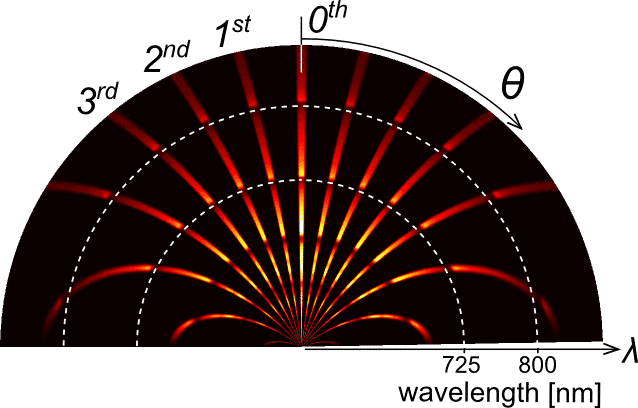
Understanding Sparse Hole Arrays Emission with Angle-Resolved Extraordinary Optical Transmission

Nano holes in metal, one of the most used structure for plasmon lasers, are studied since the discovery of Extraordinary Optical Transmission (EOT) of metal nanoholes arrays [1]. We use the results from EOT to investigate the angular emission properties of nanohole arrays under the excitation of plasmonic resonances.
We use sparse nanoholes arrays with surface plasmon resonances present at the gold-glass interface, and measure the transmitted intensity as a function of angle and wavelength. The grating nature of the nanostructure results in several diffraction orders which can be individually studied (see figure for measured data at a fixed lattice spacing). The relative intensities of these orders effectively sample the angular emission profile of the individual holes in the array. Additional angles can be probed by changing the array lattice constant.
Using a known model for the EOT [2], we separate the field diffracted through the hole in a direct component and a component coming from the plasmonic resonances. We find that in the p-polarization the observed emission profile is consistent with the emission from a single hole [3] and that the magnetic nature of the dipole induced by the field polarizing the hole dominates over the electric dipole component, which should be absent anyhow for symmetry reasons. For the s-polarization the observed transmission profile is wider than expected from theory [3]. A full explanation of this intriguing deviation is being investigated at the moment this abstract is written.
[1] Ebbesen, T. W., Lezec, H. J., Ghaemi, H. F., Thio, T. & Wolff, P. A. "Extraordinary optical transmission through sub-wavelength hole arrays", Nature 391, 667–669 (1998).
[2] Liu, H. & Lalanne, P. "Microscopic theory of the extraordinary optical transmission", Nature 452, 728–731 (2008).
[3] Yi, J. M. et al. "Diffraction Regimes of Single Holes", Physical Review Letters 109, 023901 (2012).
mariani.flavio@gmail.com
Powered by Eventact EMS